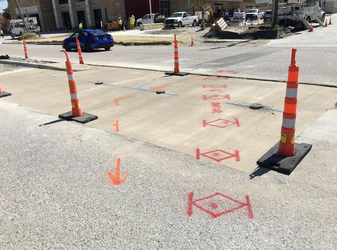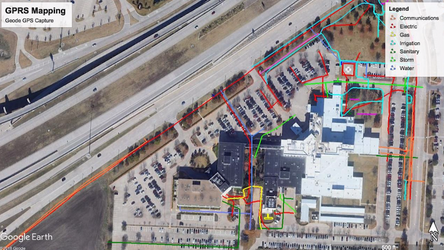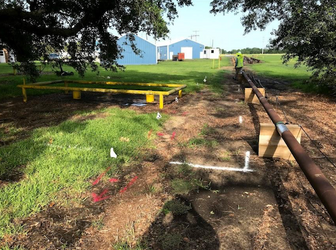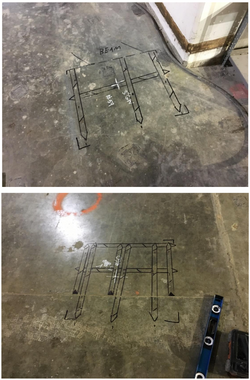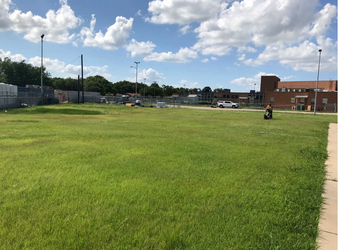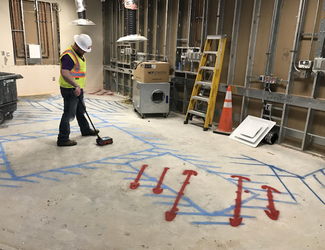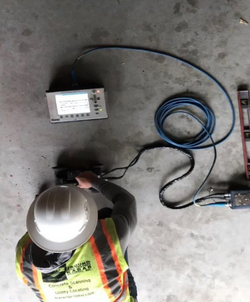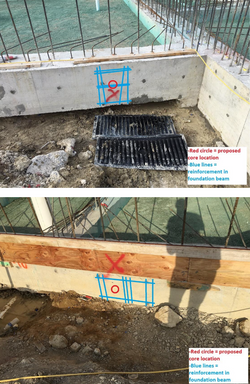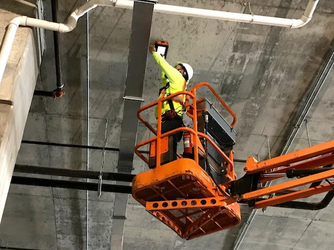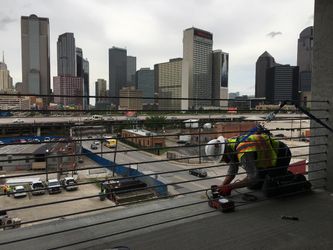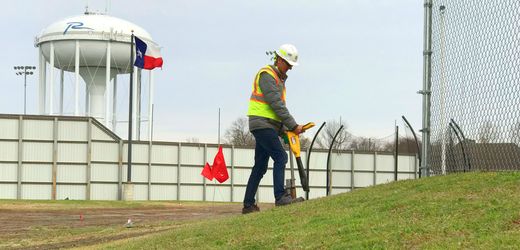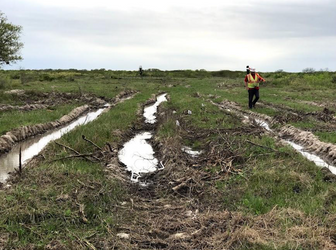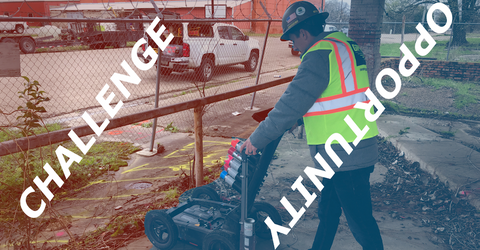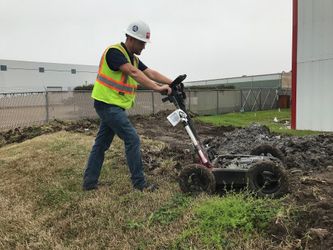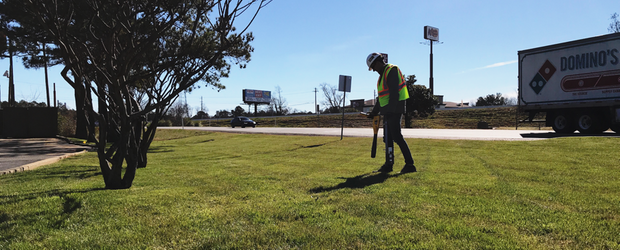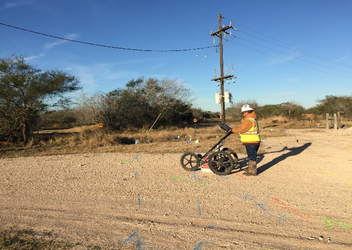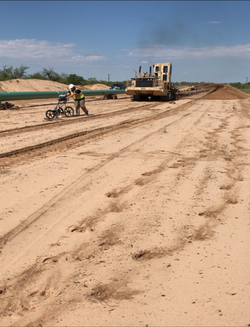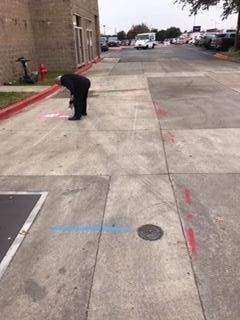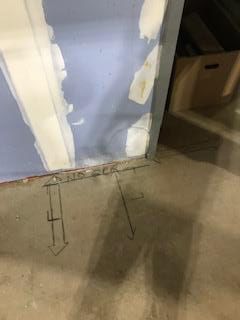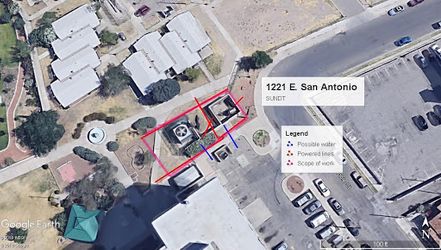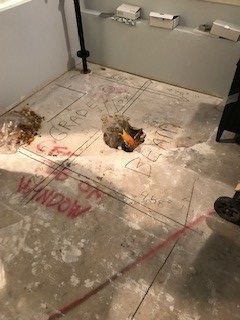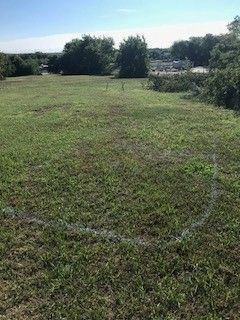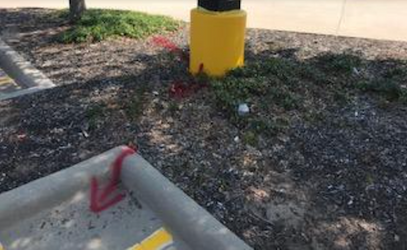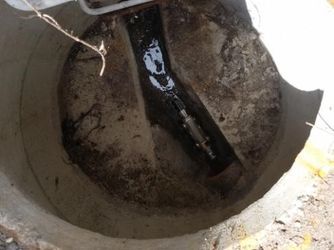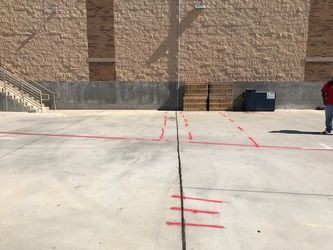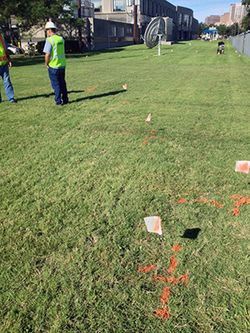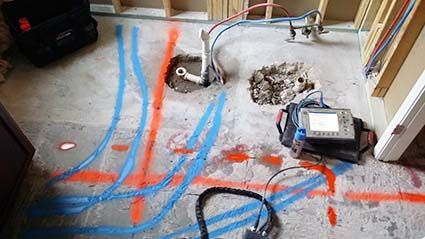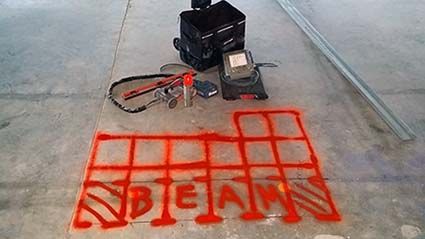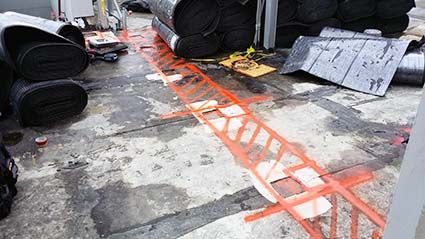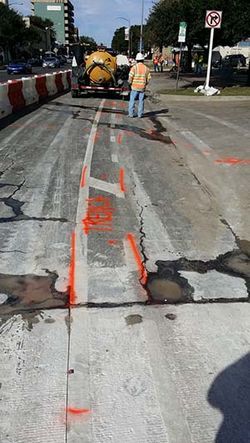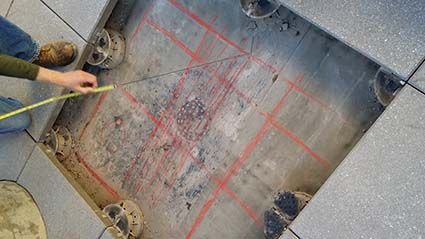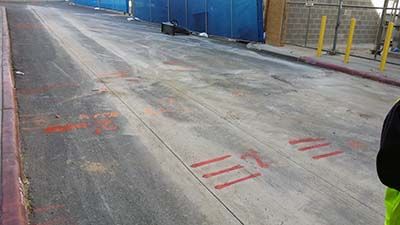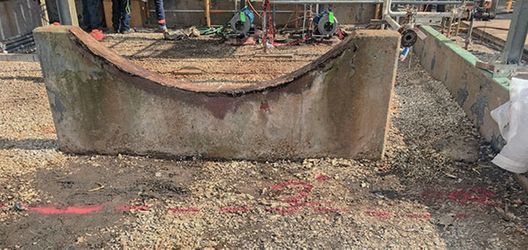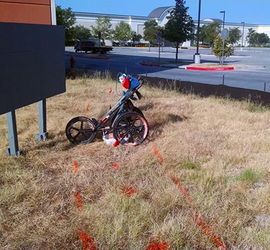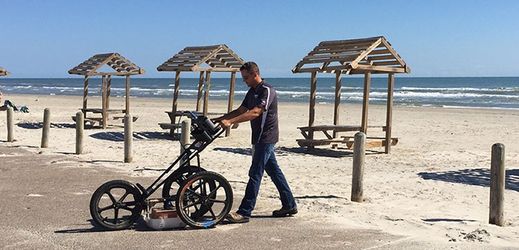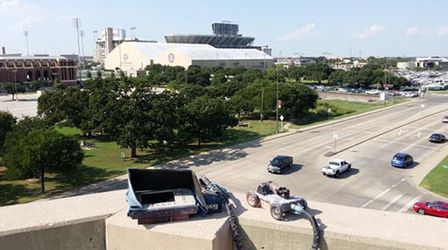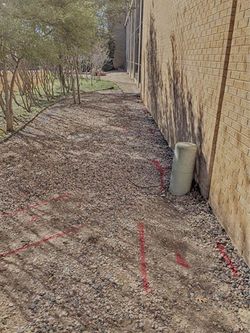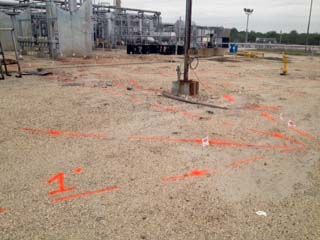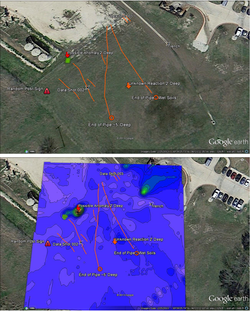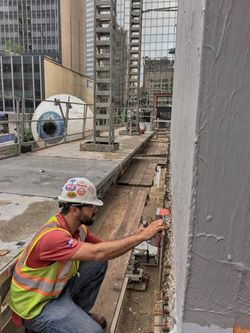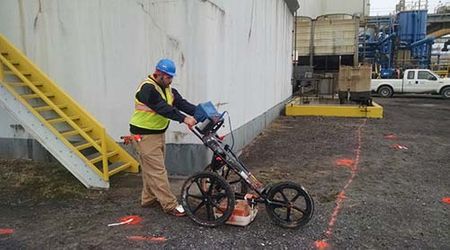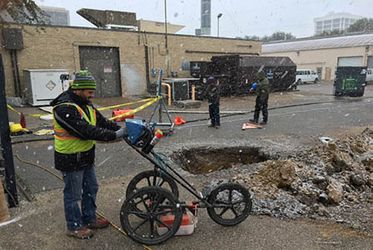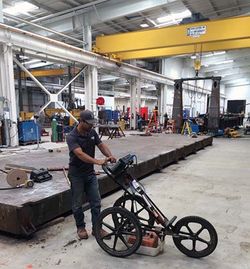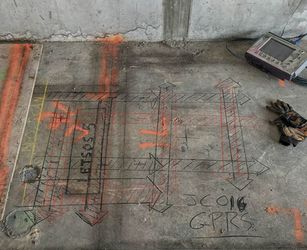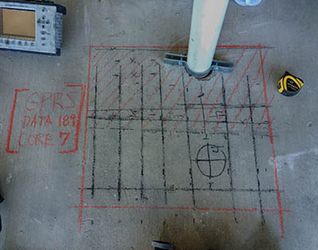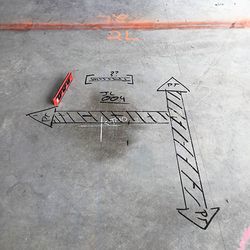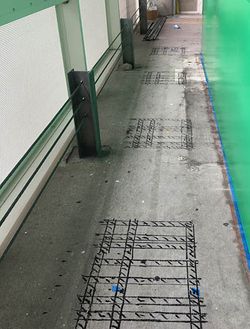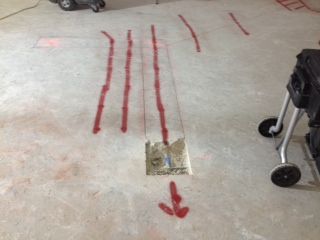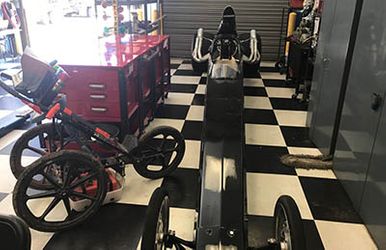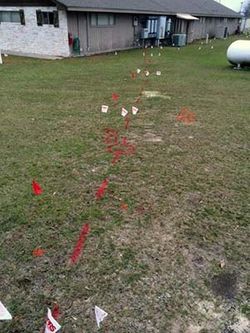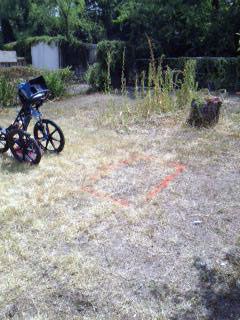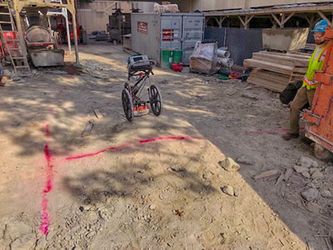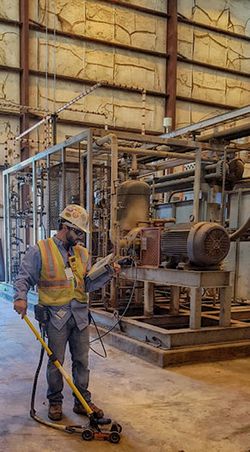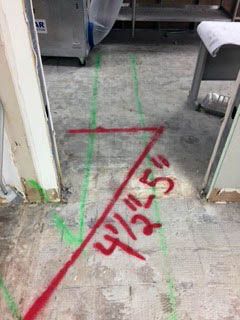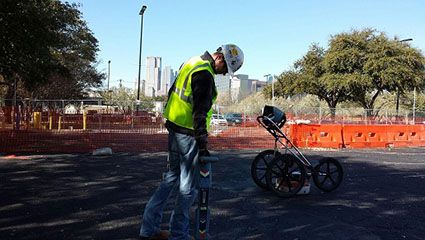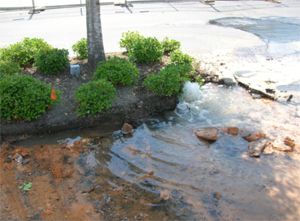Past Project Archive
Featured Concrete Scanning Story
GPRS Scans For Conduits At Football Stadium
Ground Penetrating Radar Systems was contacted by a general contractor to locate the conduits inside a suspended slab at the Cowboys football stadium in Dallas, Texas. The contractor needed multiple core drills and anchor locations cleared for the ventilation and piping for the new restaurant opening in the stadium. Concerned about hitting a conduit and shutting down sections of the stadium, or the entire stadium itself, the contractor called upon GPRS to locate all the electrical inside the slab before making any penetrations.
Featured Utility Locating story
Ground Penetrating Radar Underground Utility Locate
Ground Penetrating Radar Systems works extensively with refineries. Prior to digging up old underground utilities, Brandon Campos-GPRS Texas was contacted to locate underground utilities within the proposed excavation path in San Antonio, Texas. Multiple lines were located using Ground Penetrating Radar and the Radio Detection Device.
We recently received the opportunity to work for a customer who historically has relied primarily on classic X-ray technology rather than ground penetrating radar (“GPR”). They split their project between X-ray and GPR scan areas. By the time we finished the project, the PM contact encouraged us by telling us that they were very impressed with our results and that we would receive a lot more business from them in the future.
Here, I think are some of the reasons why:
Scheduling Flexibility: GPRS can generally mobilize to a site within 3 business days, and we can work day or night, with very little impact to the work around us. Classic X-ray produces harmful radiation that generally requires the work to be done at night with the building cleared. Because GPR uses much lower frequencies, it is as safe as a cell phone and does not require the space to be cleared.
Cost: Our total quote for this entire project was less than 20% that of our classic X- ray competitor. Because X-ray requires a film to be set up for each scan area, it is time and material intensive and thus more expensive.
Safety: When we first arrived on this project, we were informed that a conduit had just been hit when a pilot hole was drilled. X-ray technology requires that pilot holes be drilled blind, and that can result in the very damages that the technology seeks to avoid. GPR operates with zero destructive effect on the slab, and can be utilized from just one side of the slab.
moreGround Penetrating Radar Systems was contacted by a construction contractor in Dallas, Texas to locate underground utilities prior to client directional boring new electric lines for site lighting. Ground Penetrating Radar Systems of Dallas, Texas was able to identify and locate numerous underground utilities including fire waterlines, communication lines, electric lines, sanitary sewer lines, gas lines, and unknown lines in the ground and mark them on the surface in order for the client to proceed with their
work safely. While on site, GPRS was also able to take on the role of consultant through expert communication with several different contractors and subcontractors working directly on the project and working in the vicinity of the concerned areas. GPRS was also able to work safely in a heavily trafficked street through constant communication and abiding by OSHA safety regulations. These utility locates allowed the client to proceed safely with their project.
Ground Penetrating Radar Systems is proud to service the Dallas-Fort Worth Metroplex with underground utility locating and concrete scanning services in the residential, commercial, industrial, energy, and environmental industries.
moreWe recently scanned a large portion of a hospital in the DFW area. The scan encompassed about 15 acres and the customer requested that GPRS mark out the locations of all utilities on site as shown above. When we approach a large project like this, we use a tested GPR methodology to ensure that the scan is comprehensive. SIM (Subsurface Investigation Methodology) includes the following steps: To begin, we search the site for visible signs of utilities, and then we open up utility features (as needed) and use the EM Locator to induce a tone onto anything conductive. By inducing a tone onto each utility, we can follow it and mark it on the surface, and we can get some idea of the depth of the line. Additionally, we know what utility is being toned, so we can generally identify the utility correctly, though this is not always the case. Sometimes, the tone can jump from one utility to another, creating confusion. It is always best to pothole our findings to verify whether all lines are identified correctly.
At this hospital, there was a large sign at the front corner that contained an electrical panel which fed some exterior outlets and site lighting. Unfortunately, this system used the same ground wiring as the irrigation control system nearby, so that when we toned the irrigation, the site lighting showed up, and vice versa. It was very difficult to distinguish between the two, but our experienced technicians were able to tell the difference. By the time we had completed this located, we had a high degree of confidence in our identification of all but two utilities, which were marked with pink, to indicate our uncertainty.
moreGround Penetrating Radar Systems was contacted by a special services contractor in the Houston Metro area to conduct a private utility scan in an area of concern at a local ExxonMobil facility. The contractor needed to excavate around some existing water valves for some underground maintenance on the water lines coming from these valves. Part of the facilities ground disturbance regulations was to call in a private utility locate to minimize any damage or dangers during this operation. Enter GPRS, the largest provider of private subsurface locating in the country. Within 24 hours, the Houston branch of GPRS mobilized to the site to conduct the locate. When GPRS arrived on site, the site contact for the contractor walked us to the area of concern and pointed out all the potential issues. Right away, we were able to determine that the area was going to be highly congested with pipelines, water lines and electric conduits based on just basic observation of aboveground indicators. GPRS conducted the scan using a 350Mhz GPR antenna and RD8100 electromagnetic pipe locator. GPRS was able to mark these out and save on potentially thousands of dollars in damage and prevent any possible injuries. Using the SIM (Subsurface Investigation Methodology) system that was created by GPRS, the contractor was provided with clear markings and a walk-through of all findings. The contractor was able to make all necessary adjustments to the drilling in real time as the GPRS Project Managers completed each of the scan areas. During this process, the GPRS Project Manager on site provided clear and concise communication with the client on all site limitations and findings. Using the information provided, the client was able to make informed decisions, keeping their project on time, under budget, and most importantly, safe. Safety is top priority with GPRS; all necessary personal protective equipment (“PPE”) is utilized at all time on all work on sites, and our goal is to get our team, and yours, home safely.
moreGround Penetrating Radar Systems was contacted by a construction contractor in Dallas, Texas to locate post-tension cables, rebar, beams, and electrical conduits in a concrete slab at one of their projects prior to drilling, anchoring and coring into the concrete slab. Ground Penetrating Radar Systems of Dallas, Texas was able to identify and locate the post-tension cables, rebar, beams, and electrical conduits in the concrete slab and mark them on the surface in order for the client to proceed with their work safely.
While on site, GPRS was also able to take on the role of consultant through expert communication with several different contractors and subcontractors working directly on the project and working in the vicinity of the concerned areas. GPRS was also able to identify the exact locations of beams directly beneath the concrete slab enabling the client to place their core locations without having to be concerned about drilling through beams on the under-side of the slab. These concrete scans allowed the client to proceed safely with their project.
Ground Penetrating Radar Systems is proud to service the Dallas-Fort Worth Metroplex with underground utility locating and concrete scanning services in the residential, commercial, industrial, energy, and environmental industries.
moreWe were recently asked to locate utilities in an area that had previously been located. The customer was aware of a few utilities, and plans showed their basic layout, but their exact locations and depths were needed. Based upon the customers understanding that not many utilities were to be found within the scan area, we scheduled the work for two hours of scanning.
Previously undetected utilities located as we began to scan, we started by locating all of the known utilities, which had previously been found, but whose markings faded beyond recognition. But we did not stop there, we continued locating and found at least 4 utilities that the previous locator had missed. Finding these utilities required more time than we had planned for the job, but we honored our original price and delivered a better locate than the customer was expecting. He asked for a business card and inquired about how he could send along positive feedback.
Experience Matters How is it possible that some locators can find utilities that others cannot? First, it must be said that not all utilities can be located. Full stop. Some utilities simply lie beyond the reach of the current technology. Other utilities are easy to find, and indeed may be very hard to miss. Between those two extremes there lies a grey area--utilities which are at the edges of what the current technology can locate. Those utilities are the reason that not all GPR companies are equal, and why it is
moreHospital jobs tend to be relatively difficult and high-stakes. Hospitals are large buildings, and they are often irregularly shaped, which means they have unusual configurations of reinforcing steel in their slabs. This makes concrete scanning more challenging than in a typical rectangular structure. Additionally, hospitals have critical utilities that can literally make the difference between life and death.
On a recent job in Plano, Texas, we scanned the floor of a hospital structure in order to map out all critical utilities and reinforcing steel, including beams. In most buildings, you can guess where the beams are simply by looking (or shining a laser) up, because beams usually run in a set pattern all the way up a structure. That was not the case on this job. Only one of the main diagonal beams was consistent between our floor and the floor overhead. The rest of the beams ran in alternate pattern, which we marked out with blue paint (see photo). Additionally, there were large pieces of rebar running diagonally across the main beams and into the slab, and there were smaller pieces of steel running in a tight grid throughout the whole scan area. We communicated the latter fact to the customer, and we were told those lines did not need to be marked, as they were consistent.
moreCLIENT PROBLEM
Client was in the process of installing bollards in a parking garage on the University of Texas campus. The bollards required to be bolted into the concrete with a penetration of three inches with a total of twenty-four penetrations. GPRS of Austin, Texas was contacted by a contractor to locate reinforcement within the concrete slab at the proposed site of the bollards. The client was looking to drill into the concrete slab to install the bollards without striking any reinforcement in the process.
HOW WE RESPONDED
GPRS arrived on site the next day with the latest equipment from one of the top industry leaders used for digital concrete imaging utilizing ground penetrating radar to map out the contents of the slab to determine how to proceed with their project safely.
RESULTS WE DELIVERED
GPRS provided illustrations marked directly on site in real time, to provide an accurate mapping of the reinforcement within the slab. This provided just what the contractor needed, so that they were able to safely anchor the bollards to the slab without compromising any structural integrity or personal safety of workers. GPRS utilizes multiple pieces of equipment that play a key role in the discovery of all reinforcement and conduits that lay beneath. The client was able to avoid all reinforcement as well as an unknown electrical conduit.
moreGround Penetrating Radar Systems was contacted by a construction contractor in Dallas, Texas to locate post-tension cables, rebar, and electrical conduits in a concrete foundation beam at one of their projects prior to drilling, anchoring and coring into the concrete slab. Ground Penetrating Radar Systems of Dallas, Texas was able to identify and locate the post-tension cables, rebar, and electrical conduits in the concrete slab and mark them on the surface in order for the client to proceed with their work safely. While on site, GPRS was also able to take on the role of consultant through expert communication with several different contractors and subcontractors working directly on the project and working in the vicinity of the concerned areas. These concrete scans allowed the client to proceed safely with their project.
Ground Penetrating Radar Systems is proud to service the Dallas-Fort Worth Metroplex with underground utility locating and concrete scanning services in the residential, commercial, industrial, energy, and environmental industries.
Ground Penetrating Radar Systems used a 1600 MHz antenna for this application, a Radio Detection (RD) device and Vivax system to detect electrical current in the concrete slab. All findings were marked on the surface directly with markers, Crayon, and tape for easy interpretation by the customer. GPRS’ 1600 MHz antenna was ideal because of its accurate depiction of what was within the concrete parking structure slab. GPR was ideal for this application due to the active work site in the surrounding areas. GPR emits no radiation and is safe for others to work in the area near the scan location.
morePrior to drilling and installing over 100 anchor and concrete core locations for new plumbing, electrical and HVAC systems, a local general contractor subcontracted Ground Penetrating Radar Systems, LLC to scan and locate post tensioned cables throughout the entire store. The contractor knew that the concrete slab on the floor and ceiling contained post tensioned cables and wanted to avoid them for the duration of all drilling. This was the contractor’s first time working with GPRS and after asking around other general contractors, many other companies referred GPRS as their go-to concrete scanning company. Since the anchor locations were on the ceiling, GPRS also rented and provided an aerial lift with certified Project Manager’s for the duration of the project. After mobilizing to the jobsite, the Ground Penetrating Radar Systems team was able to locate multiple post tensioned cables and conduits running in the floor and ceiling slabs. Many of the areas where the contractor wanted to drill floor cores had conduits running directly through the area. GPRS was able to mark these out and save on potentially thousands of dollars in damage and prevent any possible injuries. The GPRS team was also able to locate multiple post tensioned cables directly in the areas of concern in the ceiling anchor locations and floor core locations. Using the SIM (Subsurface Investigation Methodology) system that was created by GPRS, the contractor was provided with clear markings and understanding of all findings. The contractor was able to make all necessary adjustments to the drilling in real time as the GPRS Project Managers completed each of the scan areas. During this process, the GPRS Project Manager on site provided clear and concise communication with the client on all site limitations and findings. Using the information provided, the client was able to make informed decisions, keeping their project on time, under budget, and most importantly, safe. Safety is top priority with GPRS; all necessary personal protective equipment (“PPE”) is utilized at all time on all work on sites, and our goal is to get our team, and yours, home safely.
moreGround Penetrating Radar Systems was contacted by a construction contractor in Dallas, Texas to locate post-tension cables, rebar, and electrical conduits in a concrete parking structure slab at one of their projects prior to drilling, anchoring and coring into the concrete slab. Ground Penetrating Radar Systems of Dallas, Texas was able to identify and locate the post-tension cables, rebar, and electrical conduits in the concrete slab and mark them on the surface in order for the client to proceed with their work safely. While on site, GPRS was also able to take on the role of consultant through expert communication with several different contractors and subcontractors working directly on the project and working in the vicinity of the concerned areas. Ground Penetrating Radar Systems also utilized the proper safety equipment in the form of fall protection ensuring no safety issues. These concrete scans allowed the client to proceed safely with their project.
Ground Penetrating Radar Systems is proud to service the Dallas-Fort Worth Metroplex with underground utility locating and concrete scanning services in the residential, commercial, industrial, energy, and environmental industries.
moreWe often get asked whether we went to school to learn GPR/ utility locating. Our technology and industry remain somewhat novel to most casual observers, who want to know what it takes to become an expert in GPR. The answer to the school question is both ‘yes’ and ‘no’.
No, the utility locating industry is not large enough to warrant degree programs. But, yes, GPRS has a world-class training program, fit with dedicated instructors, a well-developed classroom curriculum, and even a ‘practice’ field of deliberately positioned buried utilities for the new trainees to test their skills on. We also have an advanced course for continuing education and many hours of online videos and interactive content. All new team members go through a months-long ride along, and we have rigorous quality control protocols and SOP’s. We have an external certification (www.simspec.org) that governs both our initial and ongoing training standards.
But there is another, even greater sense in which most of us can say, “Yes, I went to school for this”. That is, we regularly scan America’s school and universities, and those jobs are some of the most challenging and rewarding jobs we do. In our experience, schools have more utilities per acre than almost all other non-industrial facilities (second only, perhaps, to theme parks). Schools, especially larger universities, are often constructed in phases, through an iterative process, as they grow and expand. Utilities are layered on top of one another, sometimes abandoned in place, sometimes redirected at odd angles.
morePrior to excavating and trenching for over 100 wind turbine foundations, 17 miles of access roads and 51 miles of collection lines, a major wind energy contractor subcontracted Ground Penetrating Radar Systems, LLC to locate active and abandoned underground utilities throughout the entire project area. The contractor knew of multiple oil and gas pipelines running throughout the project and needed GPRS to confirm the known utilities and identify any unknown or abandoned utilities. After working with GPRS on dozens of other projects, they knew exactly who to call to meet their needs on this project. After mobilizing to the jobsite, the Ground Penetrating Radar Systems’ team was able to locate and confirm multiple pipelines within the excavation areas on just the first day on site. While scanning one of the wind turbine foundation areas, GPRS marked an unknown buried utility that ran directly through the excavation area. This utility was not marked on any historical map nor was it known by the contractor ahead of time. Using Electromagnetic Line Locating and GPR technologies, they were also able to trace out the utility throughout the entire area of concern. Upon reaching the end of the project boundary, the utility was exposed above ground and turned out to be an abandoned gas pipeline. The contractor was able to visually see all of the findings due to the easy to interpret flagging and staking system used by GPRS to mark all their findings. After the area was scanned, the gas pipeline location was collected via GPS and exported to a daily Google Earth KMZ file for the client to use in the future, holding a convenient and precise permanent record. A post scan walkthrough was also conducted with the GPRS team and the client to explain all our findings and answer any questions the client may have. After reviewing the results, the client was grateful that GPRS was able to identify the previously unknown utility. The contractor went back to the drawing board and made an alternate wind turbine foundation location based on the findings, avoiding the buried pipeline entirely. During this process, the GPRS Project Manager on site provided clear and concise communication with the client on all site limitations and findings. Using the information provided, the client was able to make informed decisions, keeping their project on time, under budget, and most importantly, safe. Safety is top priority with GPRS; all necessary personal protective equipment (“PPE”) is utilized at all time on all work on sites, and our goal is to get our team, and yours, home safely.
moreIt has been a busy and cold winter, and we have encountered a few recent challenges, which we have taken as opportunities to go above and beyond for our customers. Sometimes challenges are really just opportunities in disguise—opportunities to grow, to serve others, to innovate. Here are a few recent challenges (opportunities) that our team has encountered.
moreThe Henry B Gonzales convention center in San Antonio is undergoing multiple facility renovations. The contractor’s main concern was to protect the existing infrastructure during excavation. French drains are perforated PVC pipes the typically installed on top of the clay layer of soil underground to insure the proper movement of groundwater, thus preventing standing water and over watering to occur. Trough drains are a linear floor drain typically used in preventing standing water on smooth surfaces where water is prevalent. The contractors were told to be cautious when digging due to all the utilities in the trenching areas.
GPRS was able to respond within 24 hours to identify private underground utilities in the area of construction. We utilized our time on site efficiently by ensuring the client’s needs were met and exceeded by first taking time with the facility managers, engineers and contractors to understanding the specific areas where the drains were to be installed. Gaining access to the known utility structures in the surrounding areas as well as viewing accessible as-built drawings to ensure all known utility structures were identified. We took notice of obstructions and possible complications on site and brought them to the client’s attention.
morePrior to excavating and trenching for new electrical and communication conduit install, a local electrical contractor subcontracted Ground Penetrating Radar Systems, LLC to locate possible utility lines in select areas throughout the property. The contractor noticed multiple electrical conduits running into the ground near the area they were about to dig and needed to safely clear the area of underground utilities. After a quick internet search for Houston area utility locators, the contractor got in touch with GPRS. After mobilizing to the jobsite, the Ground Penetrating Radar Systems team, was able to locate the electrical conduits that the contractor noticed. During the site walkthrough, GPRS also noticed evidence of multiple other utilities in the area.
Using Electromagnetic Line Locating and GPR technologies, they were also able to detect a handful of other underground utilities, including communication lines and water lines. The contractor was able to visually see all of the findings due to the easy to interpret color coding and flagging system used by GPRS to mark all their findings. After each area was scanned, the utility line locations were collected via GPS and exported to a Google Earth KMZ for the client to use in the future, holding a convenient and precise permanent record. A post scan walkthrough was also conducted with the GPRS team and the client to explain all our findings and answer any questions the client may have. After reviewing the results, the client was grateful that GPRS was able to mobilize in such a short notice to safely clear the jobsite. Using the information provided, the client was able to make informed decisions, keeping their project on time, under budget, and most importantly, safe. Safety is top priority with GPRS; all necessary personal protective equipment (“PPE”) is utilized at all time on all work on sites, and our goal is to get our team, and yours, home safely.
moreGPRS recently did three jobs at the DFW International Airport. These jobs were back to back to back for different contractors. Ground Penetrating Radar Systems scanned for utilities around an underground storage tank (UST), as well as for the tank piping, then later scanned a concrete foundation to mark out footers and steel, and finally scanning for utilities in the large open area pictured above where peers will be driven 30 feet into the ground. It was an extremely cold day, and it is difficult to see in the picture but there was ice frozen to the ground. GPRS has performed in most scenarios around the United States after completing hundreds of thousands of jobs since its inception in 2001. We are ready to handle whatever difficulties your job may include.
UST Search – For the job involving the UST, the tank itself was buried too deep to see with the GPR, but there was a small underground tunnel where pipes from the tank had previously run into the airplane hanger. We were able to run a traceable rodder down that tunnel and it navigated right to the UST. We induced a tone onto the rodder line and we were able to capture the piping from the tank, and the location of the tank itself.
moreThe client was contracted to install bollards in a parking garage on the campus of The University of Texas at Austin. Twenty-four bollards were to be installed and secured to the concrete with three-inch long concrete anchors. GPRS of Austin, Texas was hired by the client to scan and locate reinforcement within the concrete slab in the proposed bollard locations. The purpose of the scan was to identify and mark the existing post tensioned cables so they could be avoided when drilling for installation of the anchors.
GPRS arrived on site within 24 hours of the client’s request. Using the latest equipment from one of the industry leaders, GPRS employed ground penetrating radar to map out the contents of the slab and provide the client with precise locations of the critical embedments so the client could safely install the bollards without incident.
GPRS provided exacting marks, representing the embedded steel reinforcement, directly on the concrete surface in real time, giving the client precisely what they needed. The client was then able to safely anchor the bollards to the slab without compromising any structural integrity or personal safety of the workers on site. GPRS utilizes multiple pieces of equipment that play key roles in the discovery of all reinforcement and conduits for your subsurface projects. The client was able to avoid all reinforcement as well as an unknown electrical conduit that was detected during the initial scan.
moreWe have recently received an influx of major utility locate requests in Dallas, TX. Many of these have been for telecommunications companies doing directional bores to install new fiber optic cables. Others have been in the energy industry, providing utility locates at solar farms or oil refineries. Still others have been for mechanical, electrical, and plumbing contractors installing new utilities.
Whether we get a call from a customer trying to locate a single line, a request to map the utilities at an entire facility, or a call from an executive trying to set up a national contract, we have the resources to get any job done with speed and professionalism. We believe that every customer and every job deserves quality, communication, and a quick turn around. That is why we continually hire and expand our operation, pressing to keep our availability high. That is why we invest continually in new technology, and upgrade our equipment on a faster than ever replacement plan. That is why we continue to invest in our training department, and are recognized by our customers and competitors as the industry leader in GPR, utility locating, and concrete scanning.
morePrior to drilling and hand augering operations for environmental sampling and monitoring well installs, a local environmental agency subcontracted Ground Penetrating Radar Systems, LLC to locate possible utility lines in select areas throughout the property. Above-ground gas markers indicated the presence of three potential gas lines crossing through a future work area requiring this environmental investigation. With the help from the Ground Penetrating Radar Systems team, nine additional gas lines were found to be crossing the concerned areas. After each area was scanned, the utility line locations were collected via GPS and exported to a Google Earth KMZ for the client to use in the future, holding a convenient and precise permanent record. With the findings from the GPRS team, our client was able to safely position new sampling locations to avoid any obstacles on site. During this process, the GPRS Project Manager on site provided clear and concise communication with the client on all site limitations and findings. Using the information provided, the client was able to make informed decisions, keeping their project on time, under budget, and most importantly, safe.. Safety is top priority with GPRS; all necessary personal protective equipment (“PPE”) is utilitized at all time on all work on sites, and our goal is to get our team, and yours, home safely.
morePrior to installing a new 60 mile underground pipeline, an energy company subcontracted Ground Penetrating Radar Systems, LLC to locate all existing underground utilities within the proposed trench path. After completion of this project, we were able to provide our client with more than 20 unknown lines crossing pipeline right of way. With the help from the Ground Penetrating Radar Systems team, the subcontractor was able to complete the project with no line strikes and no lost time on site. After each area was scanned, the utility line locations were collected via GPS and exported to a Google Earth KMZ for the client to use in the future, holding a convenient and precise permanent record. With the findings from the GPRS team, our client was able to safely expose all underground anomalies prior to excavation. At the completion of each day, our GPRS team communicated thoroughly with the Superintendents to provide the results of the findings. GPR shows data in real time, the results were communicated to the customer with the location and depths shown using spray paint and white pin flags. Safety is top priority with GPRS; all necessary personal protective equipment (“PPE”) is utilized at all time on all work on sites, and our goal is to get our team, and yours, home safely.
moreProject manager Jim Cordoza from GPRS Texas has worked many job sites, performing utility locating of industrial waterlines, concrete scans for post-tension cables, and more. Check out these videos to learn why GPRS is the best option for all of your underground utility locating needs. Contact your local project manager today at www.gp-radar.com.
moreGround Penetrating Radar Systems was contacted by Austin Commercial to locate post tension cables and nine beams at 2000 Ross Ave Dallas, TX. The contractor needed a core drilled through each of the nine beams. They contacted GPRS to locate post tensions cables due to the holes drilled in the precast not being to right size. They wanted this done so they wouldn’t hit any more post tensions cables.
Ground Penetrating Radar Systems used a GSSI 1600 MHz antenna for this application to locate the pt cables. All findings were marked directly on the concrete at customers request for easy interpretation.
For a similar scan on your job site please contact Austin Hearn at 405-441-8686 or at austin.hearn@gprsinc.com. Sonar has also been used to locate utilities in Fort Worth, Arlington, Wylie, and Plano, Texas. For safety, X-ray is also used to locate critical post tension cables inside concrete to prevent injuries while cutting or drilling.
moreGround Penetrating Radar Systems was contacted by an environmental company to locate underground utilities prior to 4 soil borings that were going to be drilled through a parking lot scoped to have an addition added onto the hospital over the next 9 months. In a parking lot like the one shown to the right, the customer is concerned about striking site lighting, other unknown electrical, water lines, sewer lines, and unknown sprinkler lines. GPRS was able to come out and successfully locate exactly where the all the underground utilities were that would possibly be obstructing their drilling activities. The client understood that by having Ground Penetrating Radar Systems out to locate all subsurface utilities, they saved on time and money by preventing a line hit and repair. This was crucial for the project to remain on time and to officially get started.
moreGround Penetrating Radar Systems was contacted by a general contractor to locate the post tension cables and conduit running through a residential slab of concrete. The general contractor was concerned of the safety issues with his contractors hitting an electrical cable or a high tension cable. GPRS was able to come on site within 24 hrs of the requested job and safely locate all of the post tension and conduit running inside the slab of concrete. There is an extreme amount of pressure on post tension cables and if one is struck or cut, this could create an extreme safety issue for the other contractors on site and create a serious structural risk to the building. Conduits are another important object to locate while saw cutting or core drilling. The electrical safety hazard to the contractor striking the line would be at extreme risk of electrocution. This can also pose to be a costly mistake to fix for the general contractor on site.
moreGround Penetrating Radar Systems, LLC. was contacted by a contractor that needed to know the location of utilities prior to trenching earlier this month. The client's primary concern was to determine the location of any utilities or other near-surface items within the excavation area prior to digging so that they can place directional signs. The project consisted of clearing approximately 1000’ of trench line. Utilizing the latest in GPR and Radio Detection technology, Joseph R. Granados of the EL Paso, TX Office scanned the site and was able to mark out several utilities traveling through the proposed areas. All of the utilities that were located were then marked directly onto the service in real time while GPRS was on site. The use of ground penetrating radar allowed the client to stay safe while digging and helped to keep them on their tight completion schedule. With the professional services provided by GPRS, no utilities were struck during the excavation of the three areas allowing the client to stay safe on this project.
If you have a project in the El Paso, TX / New Mexico area and you need to locate utilities or need to locate items embedded in concrete such as rebar, post tension cables, or conduits, please contact the TX/NM Office for a free estimate. If you need more information or need a cost proposal for your next project please contact, Joseph R. Granados at (915) 765-7442 or joseph.granados@gprsinc.com.
moreGround Penetrating Radar Systems, LLC. was contacted by a contractor that needed to know the location of utilities prior to trenching earlier this month. The client's primary concern was to determine the location of any utilities or other near-surface items within the excavation area prior to digging so that they can place directional signs. The project consisted of clearing approximately 2-500’’ of trench line. Utilizing the latest in GPR and Radio Detection technology, Joseph R. Granados of the EL Paso, TX Office scanned the site and was able to mark out several utilities traveling through the proposed areas. All of the utilities that were located were then marked directly onto the service in real time while GPRS was on site. The use of ground penetrating radar allowed the client to stay safe while digging and helped to keep them on their tight completion schedule. With the professional services provided by GPRS, no utilities were struck during the excavation of the three areas allowing the client to stay safe on this project.
If you have a project in the El Paso, TX / New Mexico area and you need to locate utilities or need to locate items embedded in concrete such as rebar, post tension cables, or conduits, please contact the TX/NM Office for a free estimate.If you need more information or need a cost proposal for your next project please contact, Joseph R. Granados at (915) 765-7442 or joseph.granados@gprsinc.com.
moreGround Penetrating Radar Systems, LLC. was contacted by a construction company that needed to know the location of utilities prior to trenching earlier this month. The client's primary concern was to determine the location of any utilities or other near-surface items within the excavation area prior to digging. They were in the middle of the project and needed to go as soon as possible. The project consisted of clearing approximately 2000’ of trench line for a future pipeline project. Utilizing the latest in GPR and Radio Detection technology, Joseph R. Granados of the EL Paso, TX Office scanned the site and was able to mark out several utilities traveling through the proposed areas. All of the utilities that were located were then marked directly onto the service and pin flagged in real time while GPRS was on site. The use of ground penetrating radar allowed the client to stay safe while digging and helped to keep them on their tight completion schedule. With the professional services provided by GPRS, no utilities were struck during the excavation of the areas allowing the client to stay safe on this project.
If you have a project in the El Paso, TX / New Mexico area and you need to locate utilities or need to locate items embedded in concrete such as rebar, post tension cables or conduits, please contact the TX/NM Office for a free estimate. If you need more information or need a cost proposal for your next project please contact, Joseph R. Granados at (915)765-7442 or joseph.granados@gprsinc.com.
moreGround Penetrating Radar Systems was contacted by a general contractor to locate the post tension cables and conduits running through a commercial slab of concrete. The general contractor was concerned about the safety issues with his contractors hitting an electrical cable or a high tension cable.
There is an excessive amount of tension put on the cables and one strike of the cable could create serious damage to the property and building. Striking post tension cables can also cause serious bodily harm to an individual in the path of one of these lines that have been hit.
moreGround Penetrating Radar Systems was contacted by an environmental company to locate possible Underground Storage Tanks (UST’s) prior to seven soil borings that were going to be drilled. The total area that need to be covered was 4.03 acres. The customer also needed Ground Penetrating Radar Systems to clear all seven boring locations of utilities since there were buildings previously on site. In an open field like the one shown below, the customer is concerned about striking old lines from the previous buildings on site. GPRS was able to come out and successfully locate exactly where the all the underground utilities were that would possibly be obstructing their drilling activities. GPRS was also able to locate possible excavated areas that had two tanks previously removed which is in alignment with the history of the site. The client understood that by having GPRS out to locate all subsurface utilities and all possible underground storage tanks or excavated storage tanks sites, they saved on time and money by preventing a line hit and repair. The customer was also able to pinpoint exactly where they should drill, creating better test results for their project.
moreGround Penetrating Radar Systems was contacted by a general contractor to locate all underground utilities within a pick up location at a Walmart so they could add an addition to the store. They also needed to move the parking to a different area so GPRS needed to clear all of the locations of the utilities before they excavated the locations to add the additions. In a parking lot like the one shown below, the customer is concerned about striking site lighting, other unknown electrical, water lines, sewer lines, fiber optic lines, drain lines and unknown sprinkler lines. GPRS was able to come out and successfully locate exactly where the all the underground utilities were that would possibly be obstructing their excavation activities. The client understood that by having Ground Penetrating Radar Systems out to locate all subsurface utilities, they saved on time and money by preventing a line hit and repair. This was crucial for the project to remain on time and to officially get started.
moreInspecting the internal condition of gravity utility pipes is not a new thing in the world of underground utilities. However, it is something that has become increasingly important as many gravity utility infrastructures have become older, and the pipes have been compromised over the years. A problem with a sewer or storm drain pipe can cause major concerns, such as: sink holes, ground water contamination, soil contamination, sewage overflows, and many more.
moreGround Penetrating Radar Systems was contacted by a general contracting company to locate underground utilities prior to saw cutting a 20’x30’ slab of concrete to repave the parking lot. The customer was hired to put in a dumpster bay in which they need to redo the concrete and they didn’t want to hit any critical utilities while saw cutting to remove the concrete. In a parking lot like the one shown below, the customer is concerned about striking site lighting, other unknown electrical, water lines, sewer lines, and unknown sprinkler lines. GPRS was able to come out and successfully locate exactly where the all the underground utilities were that would possibly be obstructing their drilling activities. The client understood that by having Ground Penetrating Radar Systems out to locate all subsurface utilities, they saved on time and money by preventing a line hit and repair. This was crucial for the project to remain on time and to officially get started.
moreGround Penetrating Radar Systems (GPRS) of the Houston, TX office was called by Lectrus Construction to locate any subsurface utilities prior to installing new solar panel field at the Texas Medical Center. Nate Loyola, technicians on site, used GPR (Ground Penetrating Radar) 400 MHz antenna to locate and mark out the potential subsurface utilities such as storm drains, energized lines, natural gas lines and other telecom and fiber optics below the surface. Paint, flags and wooden lath are always used to help clearly identify subsurface utilities.
GPRS is the safe, accurate, and effective method for locating obstructive subsurface utilities. With this innovative technology, we use zero radiation and can assemble, scan and mark out in real time. GPRS of the Houston, TX office covers Humble, Spring, Tomball, The Woodlands, Cypress, Katy, Missouri City, Pearland, and Pasadena, TX. For more information on utility locating or to arrange a Lunch and Learn Presentation, please contact Glenn Zebrowski – Regional Manager at (281) 728-7025 or Nate Loyola – Project Manager at (832) 262-3438. You can also email Glenn at Glenn.Zebrowski@gp-radar.com or Nate at nate.loyola@gprsinc.com. Call before you dig.
moreRenovating a bathroom can be a headache, especially if you’re trying to cut a hole in order to move a drain and you end up severing a water line in the process. Austin, Texas area general contractors know how to avoid these types of headaches: they call GPRS. In the right hands, GPR can work wonders; even locating precise locations of water lines, post-tension cables, and grade beams.
To learn how a skilled GPR technician can keep you headache free, contact Corey Brecht at (512) 417-6105 or via email at corey.brecht@gprsinc.com.
moreWhen a plumber was working on a building renovation in Austin, Texas, he determined that the project required the installation of a water line which would pass through a slab of concrete. Knowing the potential risk and costly damage that could result from blindly cutting into a concrete slab, the plumber called Corey Brecht with GPRS of Central Texas to scan the area. Using cutting edge ground penetrating radar technology, Corey was able to locate the reinforcing steel beams that ran through the concrete slab and determine where the beam edge began. Thanks to the clear and accurate markings Corey made onto the concrete, the plumber was able to start drilling into the slab so that the new water line could be installed.
To learn how GPRS can help you cut safely, contact Corey Brecht at (512) 417-6105 or via e-mail at corey.brecht@gprsinc.com.
moreA general contractor who was working on a hotel project in Austin, Texas asked our central Texas office to locate bundles of PT cables prior to drilling plates for a hand rail installation. The GPRS technician was able to locate the bundles with an accurate depth in a timely manner.
To find out how GPR can help you drill safely, contact Corey Brecht at (512) 417-6105 or via e-mail at corey.brecht@gprsinc.com.
moreDuring a utility relocation project in downtown Austin, TX, contractors brought Corey Brecht with GPRS out to the site to help them identify deep utilities such as sewer lines. Previous excavations to install these utilities left behind deviations in the subgrade that were identifiable with GPR. This helped the construction crew identify the precise location of the deep utilities.
To see how GPRS can help you find what’s been buried, call Corey Brecht at (512) 417-6105 or email at corey.brecht@gprsinc.com.
morePrior to drilling holes through a roof deck to install new storm drains, plumbers on site decided to contact GPRS to locate post tension cables first. Central Texas Regional Manager Corey Brecht was able to use non-destructive GPR testing to identify critical reinforcing steel and other obstructions within the concrete so that the plumbers could core through the deck safely.
To find out how GPRS can safely help you find rebar, post-tension cables, and conduit in your slab, please call Corey Brecht at (512) 417-6105 or email at corey.brecht@gprsinc.com.
moreWhen contractors in El Paso needed to dig a trench to install a new run of utilities, they knew they could possibly damage other buried utilities. For this reason, they contacted GPRS to help them identify any obstructions that might cross their path. After a thorough inspection, GPRS was able to identify a dozen buried obstructions that would likely have been struck by excavators during digging.
moreA petrochemical facility in Houston, TX called GPRS to locate underground obstructions prior to expanding their rail scale complex. GPRS was able to keep the client safe, and the facility operating without issues by marking out all unknown lines in the ground. As the oil and gas industries expand in the gulf coast region, GPRS can keep your projects safe, and on or ahead of schedule by reducing the risks of line strikes in the ground.
moreGround Penetrating Radar Systems, LLC. can identify underground anomalies such as utilities, obstructions, and subsurface voids using non-destructive testing methods. Our technicians have the ability to identify an anomaly’s depth with accuracy of 15% of the depth of the anomaly itself. This is important to note because there are often times when a customer has to excavate to a specific depth in order to install conduits, plumbing, or foundations on remodels and new construction projects. The obvious benefit of having such a high degree of accuracy is that the customer will have an indication of when to hand dig as oppose to using heavy machinery.
GPRS, LLC. offers a response time unrivaled in the industry. Often times, we can schedule your project the same day or within a few days at the most. By delivering fast and accurate service, you can be sure your project remains on schedule and within budget. Our experienced technicians set the bar and offer professional services to meet the needs of the fast paced construction industry. This GPR scan took place in at Six Flags Over Texas in Arlington, TX. The customer needed to determine the locations of the underground utilities prior to excavating the area for installation of components of a new roller coaster.
moreMLA Labs in Austin, Texas has a project where they need to establish an understanding of the soils for a new apartment/condo complex . Part of this is performing soil borings to determine the geology at the site. The drilling required them to clear the areas of any underground obstructions, utilities, and anomalies. Ground Penetrating Radar Systems technician, Austin/Houston Project Manager Jacob Blust, was called out to perform an underground GPR survey. During the survey, using real-time data collection, underground utilities were plotted out through the scope of work area so that they would not hit any utilities during the soil borings.
In addition to finding underground utilities, Ground Penetrating Radar Systems has the ability to locate storage tanks, map out rebar, post-tension and conduit prior to saw cutting and trenching, and in some cases unmarked graves. If you are interested in obtaining more information or a quote, please contact Jacob Blust at (512) 516-2898 for your projects in Houston, Galveston, Beaumont, Austin, College Station, Temple, Katy, Corpus Christi, Victoria, Central Texas, and the Texas Gulf Coast region. For any other project across Texas or the United States, please visit our “Contact Us” page for a local representative near you.
moreGround Penetrating Radar Systems (GPRS) of the Houston, Texas office was called by a local contractor to locate electric lines in order to avoid damaging conduits or risking the safety of their employees. The contractor was planning to remove the existing pavement, excavate three feet down, and stabilize the subgrade prior to laying new pavement. Allyn Hirsch, technician on site, used GPR (Ground Penetrating Radar) penetrating about four feet into the pavement, asphalt and soil, locating utilities. This GPR utility scan allowed the general contractor and sub-contractors to safely excavate, trench, and demo without jeopardizing the integrity of infrastructure, utilities, or their own safety. Furthermore, the contractor was able to maintain their tight schedule and complete their project on time.
GPR is the safest, most accurate method for locating conduits, live lines, utilities and other obstructions on your project. GPR technology has zero radiation and can assemble, scan and mark out in real time. GPRS of the Houston office covers College Station, Huntsville, Humble, Tomball, The Woodlands, Cypress, Katy, Sugarland, Pearland, Freeport, Deer Park, and Beaumont, Texas. For more information on utility locating, line locating, concrete scanning, or GPR please contact Allyn Hirsch – Project Manager at (979) 446-2321, also email Allyn Hirsch at allyn.hirsch@gprsinc.com.
moreGround Penetrating Radar Systems (GPRS) of the College Station, Texas office was called by CLR Construction to perform a concrete analysis marking out clear locations to core and drill at the TAMU parking garage. Nate Loyola, technician on site, used GPR (Ground Penetrating Radar) 1600 MHz antenna penetrating through the elevated slabs marking out the rebar, post tension and possible conduits. GPR is the safest, most accurate method for locating wire mesh, rebar, post tension/pre tension cables and conduits inside concrete slabs. With this innovative technology, GPR has zero radiation and can assemble, scan and mark out in real time. GPRS of the College Station, Texas office covers Texas A&M, Bryan, Navasota, Huntsville, and Montgomery TX.
For more information on concrete scanning or to arrange a Lunch and Learn Presentation, please contact Corey Brecht – Regional Manager at (281) 728-7025 or Nate Loyola – Project Manager at (832) 262-3438 You can also email Corey at corey.brecht@gprsinc.com or Nate at nate.loyola@gprsinc.com. Call before you core.
moreGround Penetrating Radar Systems was contacted by a landscaping contractor to scan several acres of a former explosives factory for utility lines. The contractor was planning to plant several large trees, and to rerun an irrgation line, however, because the new property owner did not have any records on the location of the utility lines, they decided to call GPRS to scan the area before the project got underway.
After we arrived to the job site, we scanned the property with both a 400 MHz GPR antenna, and a Radio Detection (RD) device. First, we scanned the area with GPR, and then we rescanned the area with Radio Detection to locate any lines that had an electrical current. Once the scan was finished, we explained our findings to the customer, and shortly thereafter, we provided them with a CAD file that depicted the locations of the utility lines (so that they would have a permanent record on file).
For a similar scan at your job site, and for all of your concrete scanning or utility locating needs in the Dallas/Fort Worth area, please contact GPRS Project Manager, Adam Kubicki by phone at (682) 999-0046 or by e-mail at adam.kubicki@gprsinc.com.
moreGround Penetrating Radar Systems works extensively with refineries. Prior to digging up old underground utilities, Brandon Campos was contacted to locate underground utilities within the proposed excavation path in San Antonio, Texas. Multiple lines were located using Ground Penetrating Radar and the Radio Detection Device. Since GPR shows data in real time, the results were communicated to the customer with the location and depths shown using spray paint and white pin flags.
moreGround Penetrating Radar Systems (GPRS) of the College Station, TX office was called by AEI Consultants to locate any subsurface utilities and possible UST’s prior to soil sampling in Bryan, Texas. Nate Loyola, technician on site, used GPR (Ground Penetrating Radar) 400 MHz antenna to locate and mark out the potential utilities such as UST’s, storm drains, energized lines, natural gas lines and other telecom and fiber optics. He also used the EMI-400 (Electromagnetic Induction) Profiler giving the client up to 9’ deep of soil changes and high reflection metallic points that could lead to locating UST’s.
GPRS is capable of utilizing the latest survey equipment for collecting GPS coordinates for Google Earth and Auto CAD overlay. We can also provide clients with detailed colored maps of soil density changes showing container leaks and potential UST’s.
GPRS is the safe, accurate, and effective method for locating any subsurface utilities and underground storage tanks. With this innovative technology, we use zero radiation and can assemble, scan and mark out in real time. GPRS of the College Station, TX office covers Bryan, Navasota, Huntsville, and Conroe, Texas. For more information on utility locating or EMI imaging or to arrange a Lunch and Learn Presentation, please contact Glenn Zebrowski – Regional Manager at (281) 728-7025 or Nate Loyola – Project Manager at (832) 262-3438 You can also email Glenn at Glenn.Zebrowski@gp-radar.com or Nate at nate.loyola@gprsinc.com.
moreGround Penetrating Radar Systems was contacted by a general contractor to perform a concrete scan at an commercial office building. The contractor needed all of the reinforcement, beams, and conduit located and marked onto the surface of the slab. The lead general contractor was concerned of the safety issues with his contractors hitting electrical lines, or compromising the structural integrity of the building by accidentally coring through a beam; additionally, the contractor also wanted to make sure the reinforcement was not post tension.
GPRS Project Manager, Adam Kubicki was able arrive to this jobsite within 24hrs after being called, and during the scan he was able to safely locate the reinforcement that was running through the slab. Of course, the results of this scan was able to reassure the general contractor that there was no post tension and locating the conduits as well as all of the beams running inside the slab of concrete.
moreThis GPR scan took place on the outside face of a concrete beam in a building in downtown Dallas, Texas. The customer needed to recess the end plates after shaving a couple inches off the face of the beam in order to install the glazing correctly. Drilling into the beam to install anchors was required, and the beam is reinforced with post tensioned (PT) cables, which can cause serious injury or damage if struck in the event of a failure. The PT cables needed to be clearly marked before the customer commence.
David Hagenmayer with Ground Penetrating Radar Systems, LLC., was contracted to scan the area requested and mark out all PT cables and obstructions in the concrete. David was able to determine the precise locations of the cables and the client was then able to safely and effectively drill.
GPRS, LLC. of Dallas is the most trusted concrete scanning company because of its highly trained and dedicated technicians. We are the best at what we do, because it’s all we do. Ground Penetrating Radar is cost effective, non-hazardous, and provides data in real time. For GPRS services in North Texas, please call (972) 922-0223 or email david.hagenmayer@gprsinc.com
moreThis winter, the engineering department at Gerdau in Beaumont, Texas had GPRS perform a utility locate along a new pipe-rack pathway. Ground Penetrating Radar Systems (GPRS) was there to conduct the utility locate to mark all known and unknown gas pipelines, power, communications lines, storm drain lines, water, sanitary sewer lines, and any other anomalies that may have been in the way of the foundation piers along the pipe-rack pathway. For Gerdau’s goal of total site safety, GPR surveys are used on areas like this is to locate any hazards that may be in the way ensuring a job free of time-loss. This also ensures that nothing in the ground will be compromised and projects won’t have delays.
GPRS of Houston and the Gulf Coast was able to conduct the utility locate and map the findings directly on the ground surface for the client. They will be able to proceed with any construction that they had planned. GPRS can help keep projects on schedule by letting the clients know where problem areas may be. Utility locating is a common application for GPRS technicians.
Other services we offer are: Post-Tension Cable Location, Conduit Locating, Rebar Locating, Void Location, and more. If GPR services are needed in Houston, Beaumont, Corpus Christ, or anywhere along the Gulf Coast, call Jacob Blust at (512) 516-2898 or Nate Loyola at (281) 728-7025. Or email us about your project at jacob.blust@gprsinc.com.
moreGround Penetrating Radar Systems, LLC. can identify underground anomalies such as utilities, obstructions, and subsurface voids using non-destructive testing methods. Our technicians have the ability to identify an anomaly’s depth with accuracy of 15% of the depth of the anomaly itself. This is important to note because there are often times when a customer has to excavate to a specific depth in order to install conduits, plumbing, or foundations on remodels and new construction projects. The obvious benefit of having such a high degree of accuracy is that the customer will have an indication of when to hand dig as oppose to using heavy machinery.
moreA metal fabrication shop in Abilene, TX was scheduled to install an additional rotating table, which would be anchored to the ground below the concrete slab. This installation process would require the contractor to saw cut the slab and drill roughly three feet down to secure the anchors. This area was thought to contain a sanitary sewer and possible conduits running through or below the slab. Prior to excavation, David Hagenmayer with Ground Penetrating Radar Systems, LLC., was called out to scan the proposed locations and mark out all underground utilities and obstructions in the area. David was able to determine the precise locations and depths of the utilities. The client was then able to remove the section of concrete and install the anchors safely and without hitting any obstructions.
Ground Penetrating Radar is cost effective, non-hazardous, and provides data in real time. For GPRS capabilities in West Texas, please call (806) 201-1257 or email david.hagenmayer@gprsinc.com.
moreA large general contractor in the Houston area contacted GPRS to areas in a high-rise residential building to scan multiple core locations, marking out post-tension, and all other reinforcement/ obstructions in the slab before coring. GPRS was able to mark out all the reinforcement in the 8” slab, including rebar, post tension, conduits, and lower mats of rebar. We used multiple colors to better distinguish between the higher and lower reinforcement, as well as the thicker bundles of reinforcement, or conduits. GPRS was able to save the client money by ensuring that the structural integrity of the building was not compromised by accidentally coring through rebar or post-tension.
To learn more about the capabilities of GPRS in the South Texas Gulf Region, contact Project Manager Jim Cardoza at (713) 253-7072 / jim.cardoza@gprsinc.com or Nate Loyola at (832) 262-3438 / nate.loyola@gprsinc.com.
moreGround Penetrating Radar Systems (GPRS) of the Houston, TX office was called by a large plumbing company scanning for rebar/post tension cables prior to coring for new sleeves. Nate Loyola, technician on site, used GPR (Ground Penetrating Radar) penetrating through the elevated deck mapping the reinforcement in black and red crayons. Concrete scanning allows the general contractor and plumbers to know where the steel is inside the slab prior to coring.
GPR technology has no radiation and can assemble, scan and mark out in real time. GPRS of the Houston office covers College Station, Huntsville, Humble, Spring, The Woodlands, Cypress, Katy, Sugarland, Pearland, Freeport, Deer Park, and Generation Park, TX.
For more information on rebar locating, post tension cable locating, concrete scanning, or to arrange a Lunch and Learn presentation, please contact Nate Loyola – Regional Manager at (832) 262-3438. Email Nate Loyola at nate.loyola@gprsinc.com - Call before you core.
moreA large general contractor in the Houston area contacted GPRS to areas in a high-rise residential building to scan multiple core locations, marking out post-tension, and all other reinforcement/obstructions in the slab before coring. GPRS was able to mark out all the reinforcement in the 8” slab, including rebar, post tension, conduits, and lower mats of rebar. We used multiple colors to better distinguish between the higher and lower reinforcement, as well as the thicker bundles of reinforcement, or conduits. GPRS was able to save the client money and providing a save work environment by ensuring no reinforcement was struck when coring, and the structural integrity of the building was not compromised.
To learn more about the capabilities of GPRS in the South Texas Gulf Region, contact Project Manager Jim Cardoza at (713) 253-7072 / jim.cardoza@gprsinc.com or Nate Loyola at (832) 262-3438 / nate.loyola@gprsinc.com
moreA large national signage company contacted GPRS to perform some concrete scanning at the rental vehicle complex at Bush Intercontinental Airport after a competitor had incorrectly scanned the wrong areas. GPRS was able to correctly determine the appropriate areas to scan and mark out all the post tension and other reinforcement in the slab prior to core drilling and installing of anchor bolts. GPRS used a black crayon to mark the reinforcement on the slab, and gave the client multiple options for locations to drill. GPRS was able to save the client money and providing a save work environment by ensuring no reinforcement was struck when coring, and the structural integrity of the building was not compromised.
To learn more about the capabilities of GPRS in the South Texas Gulf Region, contact Project Manager Jim Cardoza at (713) 253-7072 / jim.cardoza@gprsinc.com or Nate Loyola at (832) 262-3438 / nate.loyola@gprsinc.com.
morePrior to saw cutting for a new trench, an electrical contractor contacted Ground Penetrating Radar Systems, LLC. Brandon Campos mobilized to the site in San Antonio, Texas to perform a GPR scan within the suggested areas. Due to the portability of the GPR antenna, the radar imaging was performed quickly and accurately. Since the results were marked directly onto the surface, the customer was able to avoid any conduit damage to the structure and injuries on-site.
moreGround Penetrating Radar Systems, LLC. was contacted to clear several planned interior and exterior soil borings inside of a race facility in Fort Worth, Texas. The firm the facility hired was tasked with drilling said borings and examining the soil samples taken to look for contamination. As numerous hydraulic lifts and several oil and gas features were located on site, borings were needed near each feature to check for the potential contamination. As this was an active facility, and other work was being performed in the vicinity, the firm needed to check all locations in a very timely manner and ensure total safety.
Gasten Schoonover with Ground Penetrating Radar Systems, LLC., was contracted to scan each soil boring location both inside and outside the facility and was able to clear each area around every lift and oil or gas feature. GPRS was able to provide much needed information to move their project along at an expedited pace. Gasten Schoonover, using Ground Penetrating Radar, was able to accurately mark out all electrical, communications, gas, water, and sewer utilities. By locating all utilities and clearing each boring, Ground Penetrating Radar Systems, LLC. was able to save the project future time, money, and ensure safety on site. Due to Ground Penetrating Radar Systems, LLC.’s quick response, rapid turnaround, quality of work, and industry-leading technology, we were able to ensure no disruptions were encountered and a very quick start and finish to drilling and examining each soil boring. Ground Penetrating Radar and Radio Detection equipment is cost effective, non-hazardous, and provides accurate data in real time. GPRS can also provide detailed reports, GPS layouts, AutoCAD and many other services. Ground Penetrating Radar Systems, LLC., is the nation’s largest company specializing in the detection of underground utilities and the scanning of concrete structures, has been in business for over 14 years, and has performed concrete scanning, void detection, UST locating, and underground utility locating projects for over 30,000 customers throughout the United States, the Caribbean, and Canada. Ground Penetrating Radar Systems, LLC. uses industry-leading equipment, provides industry-leading results, and keeps your projects on time.
moreGround Penetrating Radar Systems (GPRS) of the Houston, Texas office was called to locate underground utilities and obstructions prior to trenching a new communication line into the building. Mitch Halquist, GPRS technician on site, used GPR (Ground Penetrating Radar) 400 MHz antenna & RadioDetection to locate and mark out the underground utilities. In this photo, GPR/RD located several high voltage transmission lines as well the existing communication line crossing the proposed trench line. We were also able to locate the existing propane line, telephone line and underground drain lines for the client. With a simple precautionary phone call to GPRS prior to trenching, digging, drilling or excavating, the hazards of a possible strike or hit on an energized line or utility were avoided and the hazards crossing the trench line were clearly marked out with depth indications.
GPRS is the safe, accurate, and effective method for locating underground utilities such as power, water, telecommunications, instrumentation, pipelines or other anomalies. This innovative technology has zero radiation and can assemble on site and scan and mark out in real time. The GPRS of Houston, Texas covers Humble, Spring, Tomball, The Woodlands, Conroe, Cypress, Katy, Missouri City, Sugar Land, Pearland, and Pasadena, Texas.
moreGround Penetrating Radar Systems-Texas was contacted by the San Antonio Police Homicide Unit to help investigate a murder case. Brandon Campos mobilized to the site and provided knowledge of possible soil disturbances and depths. After GPRS’s process was complete, GPR was able to locate soil disturbances within the proposed investigation area. The findings were marked directly onto the surface and the customer was able to dig safely. Using GPRS reduces risk and cost, promotes a safe work environment, and provides non-destructive testing by locating materials such as concrete, plastic, metal, steel, and pavement.
Our Mission is to provide solutions to the critical problems our customers face regarding the location of hidden objects in concrete and underground.
For utility locating in Texas: San Antonio, Eagle Pass, Laredo, Boerne, Kerrville, New Braunfels, Del Rio, Seguin, Cotulla, Uvalde, Junction, El Paso, Temple, Austin, and San Marcos area call (210) 607-0361 or email brandon.campos@gprsinc.com
moreGround Penetrating Radar Systems was contacted by a general contractor in Dallas, Texas to locate any underground utility lines that would obstruct a trench path to put in a new conduit that would be running through a very active job site. The client was extremely concerned of hitting heavy electrical due to the active hospital surrounding the job site that could be shut down if a significant line was struck. The electricians met Ground Penetrating Radar on site and walked through the project details while marking out locations that needed to be cleared of any and all utilities.
GPRS was able to come out and successfully locate exactly where all of the utility lines were located making this a quick and easy trench line to locate. This also helped the customer to
moreWhen saw cutting or coring, utilities like electric, water, and gas lines are embedded and/or buried to keep them safe from damage that could occur on the surface by people, equipment, weather, etc. It is extremely important that when saw cutting or coring near these buried utilities, that one takes great care in ensuring these utilities remain safe from damage. This is why contractors in North Texas tasked GPRS with tracing electrical lines and scanning concrete prior to excavating an area nearby. Using specialized tools, the lines in question were safely located so work could proceed without incident.
Find out more how GPRS, LLC. can help you stay safe on your project by contacting our Project Manager, Rami Baloch at (682) 999-0046 or email at rami.baloch@gprsinc.com.
moreGround Penetrating Radar Systems was contacted by a general contractor to locate the conduits running through a commercial slab of concrete and make sure there were no post tension cables running in the slab inside a hospital in Longview, Texas. The GC was concerned of the safety issues with his contractors hitting an electrical conduit while saw cutting the hundreds of feet to trench in the new piping for the new kitchen. It was crucial that Ground Penetrating Radar Systems located the entire conduit system because serious problems could arise if there were electrical issues within the hospital.
GPRS was able to come on site within 24hrs of the requested job and safely locate the type of reinforcement running through the slab reassuring the general contractor that there was no post tension and locating the conduits running inside the slab of concrete.
moreGround Penetrating Radar Systems, LLC. (GPRS) was contacted by Medco Construction to survey proposed excavation locations prior to construction. While on site, GPRS was able to identify underground pipes, conduits, waterlines, and provide the customer with the details they needed to proceed safely.
Ground Penetrating Radar Systems, LLC. provides GPR services nationwide and have main offices throughout the state of Texas and Oklahoma, including: Dallas/ Fort Worth/Abilene, Austin/San Antonio, Houston/Corpus Christi, and Oklahoma City/Tulsa.
Andy Mix serves as a Regional Manager for the Dallas/Fort Worth Metroplex and West Texas areas and can be reached at andy.mix@gprsinc.com, or by phone at (972) 922-0223. Ground Penetrating Radar Systems, LLC. also performs other applications that include: Mapping of Electrical Conduits and Rebar, detection of Sub-Surface Voids, and detection of Underground Storage Tanks (UST’s).
moreGround Penetrating Radar Systems was contacted by a general contractor to locate the conduits inside a suspended slab at the Cowboys football stadium in Dallas, Texas. The contractor needed multiple core drills and anchor locations cleared for the ventilation and piping for the new restaurant opening in the stadium. Concerned about hitting a conduit and shutting down sections of the stadium, or the entire stadium itself, the contractor called upon GPRS to locate all the electrical inside the slab before making any penetrations.
Ground Penetrating Radar Systems used a GSSI 1600 MHz antenna and mini for this application to locate the conduits. All findings were marked directly on the concrete at customers request for easy interpretation. GPR was ideal for this application due to the active
GPRS does not provide geophysical, geological, land surveying or engineering services. If you need such services, please contact an appropriate professional.
moreThe pictures you see below are from a local attraction in Orlando, FL. The demolition contractor was removing a curb when they unknowingly broke a main feed line for the sprinkler system. This would normally not have been something difficult to remedy. However, they did not know where the shut-off valve was for the system. With this problem hundreds of gallons of water were wasted and the ground will have to be repaired prior to work continuing.
more
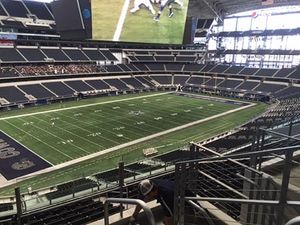
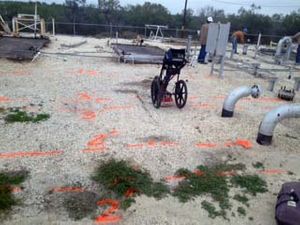
![GPRSscreen-13.32.36[16.09.2019].png](https://static.spacecrafted.com/b1be48c4cacf45889b498b123c0be796/i/bc0307bfd2f74a65ae117b395af71be9/1/4SoifmQpDrHbZJ6Vvf4aQ/GPRSscreen-13.32.36%5B16.09.2019%5D.png)
